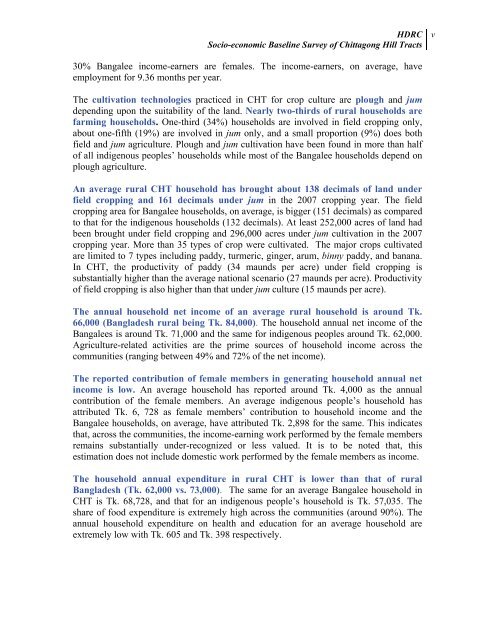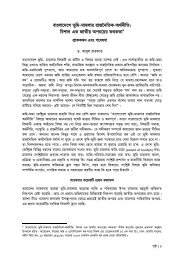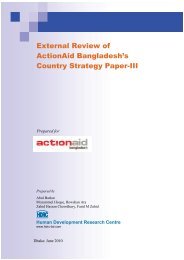socio-economic baseline survey of chittagong hill tracts
socio-economic baseline survey of chittagong hill tracts
socio-economic baseline survey of chittagong hill tracts
Create successful ePaper yourself
Turn your PDF publications into a flip-book with our unique Google optimized e-Paper software.
HDRC<br />
Socio-<strong>economic</strong> Baseline Survey <strong>of</strong> Chittagong Hill Tracts<br />
30% Bangalee income-earners are females. The income-earners, on average, have<br />
employment for 9.36 months per year.<br />
The cultivation technologies practiced in CHT for crop culture are plough and jum<br />
depending upon the suitability <strong>of</strong> the land. Nearly two-thirds <strong>of</strong> rural households are<br />
farming households. One-third (34%) households are involved in field cropping only,<br />
about one-fifth (19%) are involved in jum only, and a small proportion (9%) does both<br />
field and jum agriculture. Plough and jum cultivation have been found in more than half<br />
<strong>of</strong> all indigenous peoples’ households while most <strong>of</strong> the Bangalee households depend on<br />
plough agriculture.<br />
An average rural CHT household has brought about 138 decimals <strong>of</strong> land under<br />
field cropping and 161 decimals under jum in the 2007 cropping year. The field<br />
cropping area for Bangalee households, on average, is bigger (151 decimals) as compared<br />
to that for the indigenous households (132 decimals). At least 252,000 acres <strong>of</strong> land had<br />
been brought under field cropping and 296,000 acres under jum cultivation in the 2007<br />
cropping year. More than 35 types <strong>of</strong> crop were cultivated. The major crops cultivated<br />
are limited to 7 types including paddy, turmeric, ginger, arum, binny paddy, and banana.<br />
In CHT, the productivity <strong>of</strong> paddy (34 maunds per acre) under field cropping is<br />
substantially higher than the average national scenario (27 maunds per acre). Productivity<br />
<strong>of</strong> field cropping is also higher than that under jum culture (15 maunds per acre).<br />
The annual household net income <strong>of</strong> an average rural household is around Tk.<br />
66,000 (Bangladesh rural being Tk. 84,000). The household annual net income <strong>of</strong> the<br />
Bangalees is around Tk. 71,000 and the same for indigenous peoples around Tk. 62,000.<br />
Agriculture-related activities are the prime sources <strong>of</strong> household income across the<br />
communities (ranging between 49% and 72% <strong>of</strong> the net income).<br />
The reported contribution <strong>of</strong> female members in generating household annual net<br />
income is low. An average household has reported around Tk. 4,000 as the annual<br />
contribution <strong>of</strong> the female members. An average indigenous people’s household has<br />
attributed Tk. 6, 728 as female members’ contribution to household income and the<br />
Bangalee households, on average, have attributed Tk. 2,898 for the same. This indicates<br />
that, across the communities, the income-earning work performed by the female members<br />
remains substantially under-recognized or less valued. It is to be noted that, this<br />
estimation does not include domestic work performed by the female members as income.<br />
The household annual expenditure in rural CHT is lower than that <strong>of</strong> rural<br />
Bangladesh (Tk. 62,000 vs. 73,000). The same for an average Bangalee household in<br />
CHT is Tk. 68,728, and that for an indigenous people’s household is Tk. 57,035. The<br />
share <strong>of</strong> food expenditure is extremely high across the communities (around 90%). The<br />
annual household expenditure on health and education for an average household are<br />
extremely low with Tk. 605 and Tk. 398 respectively.<br />
v






